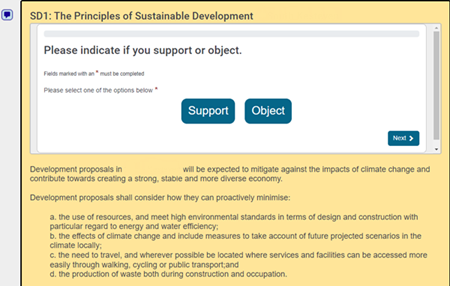
Choosing the right planning policy consultation software is crucial for ensuring effective and efficient community engagement, data collection and processing, and reporting. In this short article we share some key steps and considerations to help you make an informed decision for your plan-making digital tech requirements:
1. Identify Your Planning Policy Team Needs and Objectives
- Scope and Scale: Determine the size and complexity of the consultations you will be conducting.
- Stakeholders: Identify who will be using the software (e.g., government officials, community members, developers).
- Data Requirements: Define the type and volume of data you need to collect and analyse.
2. Key Features to Look For
- User-Friendly Interface: Ensure the software is easy to use for both administrators and participants.
- Customisation and Branding: Look for software that allows customisation to fit your specific consultation needs and will also cater for your brand styling.
- Data Collection, Analysis and Reporting Tools: Robust tools for collecting, managing, analysing and reporting on responses.
- Multi-Channel Engagement: Ability to engage with stakeholders through various channels (including online and mobile).
- Accessibility: Compliance with accessibility standards to ensure all community members can participate.
- Security and Privacy: Strong data security measures and compliance with relevant privacy laws.
3. Integration and Compatibility
- Compatibility with Existing Systems: Ensure the software can integrate with your existing IT infrastructure and tools.
- APIs and Third-Party Integrations: Check if the software supports integration with other applications you use, such as GIS systems or CRM platforms.
4. Support and Training
- Customer Support: Availability of technical support and customer service.
- Training Resources: Access to training materials, tutorials, and in-person or virtual training sessions for your team.
5. Budget and Pricing
- Cost: Compare the pricing models (subscription, one-time fee, pay-per-use) and ensure it fits your budget.
- Value for Money: Evaluate whether the features and benefits justify the cost.
6. Vendor Reputation and Reviews
- Track Record: Research the vendor’s experience and track record in providing consultation software for local planning policies.
- User Reviews and Testimonials: Look for reviews and testimonials from other local authorities that have used the software.
7. Test and Evaluate
- Free Demo: Take advantage of virtual or in-person software demonstrations to explore the functionality and benefits of the software.
- Pilot Project: Conduct a pilot project to evaluate the software’s performance in a real-world scenario.
8. Compliance and Legal Considerations
- Regulatory Compliance: Ensure the software complies with relevant regulations and standards in your jurisdiction.
- Data Ownership and Rights: Clarify data ownership, storage, and rights with the vendor.
Conclusion
Choosing the right planning policy consultation software requires careful consideration of your specific needs, the features and capabilities of the software, and the overall value it provides. By following the steps outlined above, you can make a well-informed decision that supports effective community engagement and policy development.